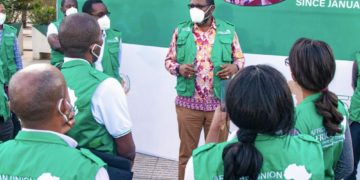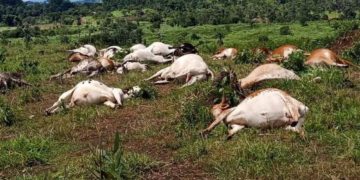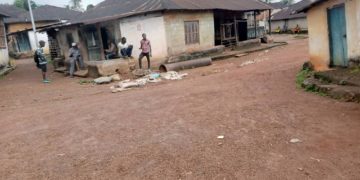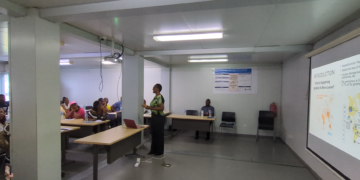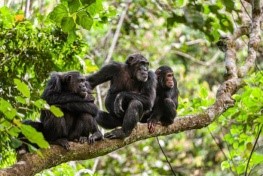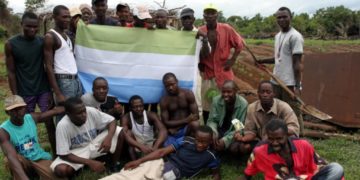By Emma Black
Sierra Leone’s lush forests, once a thriving sanctuary for its rich biodiversity, are fading under the relentless pressure of human encroachment. At the heart of this environmental crisis stands the Tacugama Chimpanzee Sanctuary, a beacon of conservation since 1995, now fiercely battling illegal land grabs that threaten its buffer zones. The nation’s chimpanzees revered as the “Jewel of the Nation” and a symbol of resilience since their designation as the national animal in 2019 face a dire future as habitat loss accelerates.
Sierra Leone’s ecological tapestry woven from tropical rainforests, mangroves, and rugged mountain ranges like the Loma and Gola has long nurtured a diverse array of species. Covering 5.47 million hectares (54,700 sq km), nearly twice the size of Guinea-Bissau, these forests provide ideal habitats for chimpanzees with abundant food and warm tropical temperatures averaging 23–30°C.
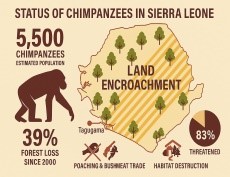
have crashed by 80% as their forests fall
to human pressure.
{Source multiple}
Yet, their population has plummeted from an estimated 5,500 individuals 12 years ago to fewer than 2,000 today a staggering 80% decline over the decade. This collapse is most severe in the Loma and Gola ranges, where primary forests have shrunk to just 20.10% of their original extent, and overall forest cover has dwindled to below 30%, driven largely by encroachment, illegal logging, and farming expansion.
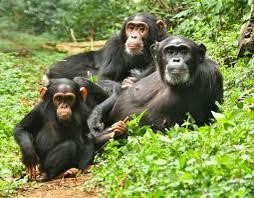
Sanctuary, now endangered not only by
habitat loss but by the illegal land grabs
closing Sierra Leone’s oldest chimpanzee refuge
Yet, their population has plummeted from an estimated 5,500 individuals 12 years ago to fewer than 2,000 today a staggering 80% decline over the decade. This collapse is most severe in the Loma and Gola ranges, where primary forests have shrunk to just 20.10% of their original extent, and overall forest cover has dwindled to below 30%, driven largely by encroachment, illegal logging, and farming expansion.
According to the Ministry of Environment’s 2024 report, Sierra Leone has lost 121,000 hectares of forest since 2010, reducing total forest cover from 18.2 million hectares in 1900 to 5.47 million hectares in 2024. This rapid decline has had catastrophic effects on wildlife habitats, particularly for the country’s last great apes.
Dr. Fatmata Kargbo, a One Health researcher at Njala University, warns “Human encroachment into chimp habitats, like in Kambui and Moyamba, disrupts their social structures and increases disease risks. Over 70% of forest edges now border human settlements, increasing human-wildlife conflict and zoonotic disease exposure.”
Since its founding in 1995 amid Sierra Leone’s civil war, the Tacugama Chimpanzee Sanctuary has been a lifeline for the nation’s chimpanzees, marking 30 years of conservation in 2025.
Founder Bala Amarasekaran recalls “It’s almost 30 years since we opened our doors, facing challenges from confiscations and rescues to surviving the rebel war, Ebola, COVID-19, and now Mpox. Each crisis has strengthened our resolve.”
Tacugama currently houses over 100 orphaned chimpanzees rescued from across 12 districts. Through education programs, radio outreach, and school clubs, it has raised public awareness and reduced the illegal pet trade in Freetown.
But today, Amarasekaran says, encroachment is the greatest threat yet. “We’re dealing with land grabbing and illegal land use around our buffer zones,” he explains. “Our sanctuary, a conservation hub and ecotourism site, had to close for nearly four months due to safety fears. The encroachment is critical, risking the entire site. Reintroduction into the wild is impossible because of habitat loss. Our priority now is to protect the few we can, to prevent extinction and zoonotic outbreaks.”
The closure a symbolic act of protest drew national attention, highlighting how unchecked deforestation now threatens not only wildlife but Sierra Leone’s conservation legacy.
Encroachment has turned chimpanzees into ecological refugees, fleeing shrinking forests for fragmented habitats. Zainab Bangura, a 45-year-old farmer from Gola Rainforest, says “I’ve seen farms replace forests near my home over 20 years, and chimps are scarce now. Encroachment is choking their space.”
Aissata Kamara, a 50-year-old gatherer from the Loma Mountains, adds “New settlements have halved the forest I knew 30 years ago. Chimps and wild herbs are harder to find. The forest that sustained us is disappearing.”
Fatmata Kallon, a 38-year-old conservation researcher from Outamba-Kilimi, explains how development projects worsen the problem:
“Encroachment has worsened over the last five years due to road projects like the EU-funded Bandajuma Liberia Border Road. It opens remote forests to settlement and logging. We’re losing the chimps we once heard every morning.”
The Outamba-Kilimi National Park, established in 1986 and spanning 1,109 sq km, is one of Sierra Leone’s oldest protected areas. But with new roads and agricultural expansion, even this sanctuary faces illegal logging and habitat fragmentation.
This displacement fractures chimpanzee social structures, increases mortality from stress and hunger, and heightens poaching risks. Experts warn that such conditions also amplify zoonotic disease transmission, as humans and apes come into closer contact along forest edges.
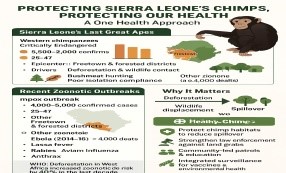
chimps into dangerous proximity, creating
pathways for Mpox, Ebola, and COVID-19
to jump species. {Source multiple}
The 2025 Mpox outbreak, with over 4,200 confirmed cases and 28 deaths by June, underscores the cost of environmental neglect. Professor Foday Sahr, Executive Director of the National Public Health Agency, says:
“Deforestation and wildlife contact create perfect pathways for viruses to jump species. The same dynamics fueled Ebola and we’re repeating the pattern.”
The outbreak, driven by a new Mpox variant (G.1), spread rapidly in forested districts where people frequently hunt or encounter wildlife. The WHO estimates that deforestation in West Africa has increased zoonotic disease risks by 40% over the last decade.
Amarasekaran adds: “clearing forests for farming and mining pushes chimps into human areas. Every destroyed forest increases the risk of the next pandemic.”
Sierra Leone’s laws appear strong on paper. The Wildlife Conservation Act (1972, amended 2020) and the Customary Land Rights Act (2022) prohibit wildlife destruction and require community consent for land use. Violators face fines up to NLe 100,000 (USD 5,000) and 10 years imprisonment.
Yet enforcement remains weak. Deputy Minister of Environment Hon. Mima Yema Sobba-Stephen admits “our laws are robust, but enforcement lags. Illegal land sales and logging often occur before authorities even know.”
Chief Manda Hawa Kannah, a traditional leader from Kambui Forest, says “I’ve led women to guard our forests for a decade, but new farms and roads keep spreading. Without legal backing, we can’t stop land grabs.”
Underfunding and inconsistent action from the National Protected Area Authority (NPAA) continue to weaken the fight against illegal encroachment.
Despite alarming statistics, the government’s response to deforestation and land grabbing remains inadequate. The Ministry of Environment’s 2024 report cites a 40% annual deforestation rate, with 95,300 hectares lost in 2023, releasing 54.6 million metric tons of CO₂.
Abdulai Dauda, Program officer at the Conservation Society of Sierra Leone (CSSL), explains “Law enforcement remains weak and politicized. We need stronger coordination between NPAA, local chiefs, and police. Conservation must become a national development issue, not an afterthought.”
CSSL, founded in 1986, continues to promote coexistence between humans and wildlife through advocacy, ranger support, and community training. However, Dauda warns that “without political will and funding, even our best efforts are like patching a leaking boat.”
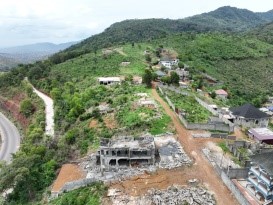
encroachment at Tacugama,
{Photo credit Bala Amarasekaran}
Today, nearly 60% of Tacugama’s 100 acres has been affected by illegal construction, charcoal burning, and logging. Similar patterns of degradation appear in Gola and Outamba-Kilimi, signaling a nationwide crisis.
From 2000 to 2020, Sierra Leone lost 30.2 million hectares of tree cover, reducing coverage from 77.9% to 40.7%, with primary forests now down to 7.5%. Subnational losses include Kenema (6,418 ha) and Koinadugu (2,980 ha).
Amarasekaran warns “We’ve survived war, Ebola, and COVID-19 but this is different. If encroachment continues, Sierra Leone will lose its last wild chimps within a generation.”
Experts are calling for urgent measures including stricter NPAA enforcement, community-led patrols, habitat restoration, and international donor support.“Conservation is not charity it’s survival,” says Dauda. “If we lose Tacugama, we lose our natural identity.”
Sierra Leone’s chimpanzees teeter on the brink of extinction, and their last refuge Tacugama is under siege. The sanctuary’s temporary closure is more than a protest; it is a desperate warning that the country’s environmental future is collapsing. To preserve both its natural heritage and public health, Sierra Leone must act now enforcing its laws, funding its protectors, and restoring the forests that once defined its beauty.

civil war, the Tacugama Chimpanzee Sanctuary
has been a lifeline for the nation’s chimpanzees,
marking 30 years of conservation in 2025.
(Photo credit Bala Amarasekaran}
This story is published with the support of Earth Journalism Network.

